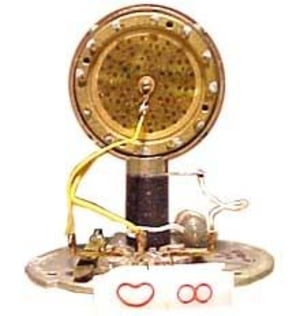2. How does a condenser microphone work?
A condenser microphone is actually a pretty complex device. An ultra-thin gold sputtered foil is mounted in front of a solid metal disk, so close they almost touch. The metallized foil is the diaphragm, the solid metal disk is what is called the back electrode; together they form a capacitor. Condenser is another word for capacitor; sometimes condenser mics are called capacitor microphones. As you may remember from physics class, a capacitor is nothing but two metal surfaces facing each other. A capacitor can store a small amount of electrical energy. The amount of this capacitance is proportional not only to the size of the capacitor but also to the proximity of the two plates. The closer they are, the higher the capacitance. This leads us back to the condenser capsule: When sound hits the thin gold sputtered diaphragm, it moves to the rhythm of the soundwaves. The solid back electrode, however, does not move. What we have, therefore, is a relative movement between diaphragm and back electrode. Which means the capsule/capacitor changes its capacitance as a result of the soundwaves that hit the diaphragm. Acoustic energy is transformed into an electrical signal! The really cool thing about condenser microphones is that the diaphragm has very low mass. The ultra-thin metallized foil weighs much less and thus moves more quickly than the thicker diaphragm of a dynamic microphone with its heavy moving coil affixed to it.

A condenser mic can follow the rhythm of the soundwaves more accurately than dynamic mics. As a result, condensers sound more natural and transparent.
But the capsule signal is not yet ready for a microphone preamp. The capsule's rhythmically changing capacitance must be translated into a rhythmically changing voltage, and this voltage signal must be amplified and transformed into a low impedance signal. This requires some (active) electronics, and hence a power supply is needed. Condenser mics usually are phantom powered. Phantom power is a voltage supplied by the preamp or mixer via the normal 3-pin XLR cables you would use for dynamic mics, too. Almost all preamps and mixers within the past 10 or so years have phantom power capability. Most mixers have only one button to engage phantom power on all microphone inputs; most external preamps have separate switches for each input. For sonic reasons, some condenser mics use tubes as amplifying devices. Tubes require very high voltages that normal phantom power cannot supply. These tube condenser microphones, therefore, must be powered by a dedicated power supply (which usually is included in the purchase).
By the way: The condenser microphone was invented by Georg Neumann, the founder of the microphone company of the same name. Interestingly enough, some of the earliest models from the 1930s were good enough to be used in recording studios today. Imagine how great today's models must be!


